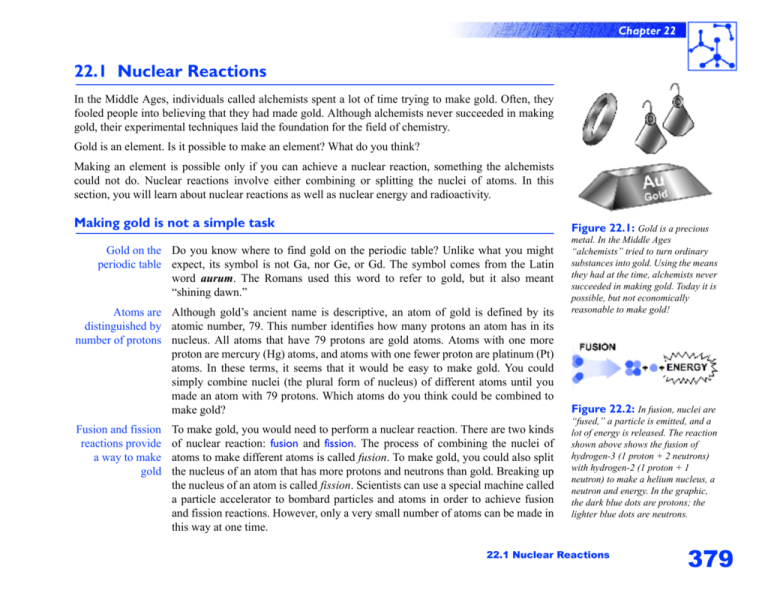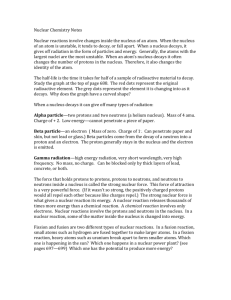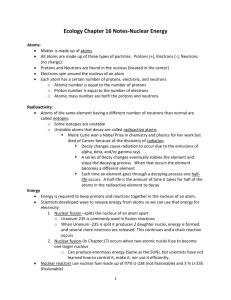22.1 Nuclear Reactions
advertisement

Chapter 22 22.1 Nuclear Reactions In the Middle Ages, individuals called alchemists spent a lot of time trying to make gold. Often, they fooled people into believing that they had made gold. Although alchemists never succeeded in making gold, their experimental techniques laid the foundation for the field of chemistry. Gold is an element. Is it possible to make an element? What do you think? Making an element is possible only if you can achieve a nuclear reaction, something the alchemists could not do. Nuclear reactions involve either combining or splitting the nuclei of atoms. In this section, you will learn about nuclear reactions as well as nuclear energy and radioactivity. Making gold is not a simple task Figure 22.1: Gold is a precious Gold on the Do you know where to find gold on the periodic table? Unlike what you might periodic table expect, its symbol is not Ga, nor Ge, or Gd. The symbol comes from the Latin word aurum. The Romans used this word to refer to gold, but it also meant “shining dawn.” Atoms are Although gold’s ancient name is descriptive, an atom of gold is defined by its distinguished by atomic number, 79. This number identifies how many protons an atom has in its number of protons nucleus. All atoms that have 79 protons are gold atoms. Atoms with one more proton are mercury (Hg) atoms, and atoms with one fewer proton are platinum (Pt) atoms. In these terms, it seems that it would be easy to make gold. You could simply combine nuclei (the plural form of nucleus) of different atoms until you made an atom with 79 protons. Which atoms do you think could be combined to make gold? Fusion and fission reactions provide a way to make gold To make gold, you would need to perform a nuclear reaction. There are two kinds of nuclear reaction: fusion and fission. The process of combining the nuclei of atoms to make different atoms is called fusion. To make gold, you could also split the nucleus of an atom that has more protons and neutrons than gold. Breaking up the nucleus of an atom is called fission. Scientists can use a special machine called a particle accelerator to bombard particles and atoms in order to achieve fusion and fission reactions. However, only a very small number of atoms can be made in this way at one time. metal. In the Middle Ages “alchemists” tried to turn ordinary substances into gold. Using the means they had at the time, alchemists never succeeded in making gold. Today it is possible, but not economically reasonable to make gold! Figure 22.2: In fusion, nuclei are “fused,” a particle is emitted, and a lot of energy is released. The reaction shown above shows the fusion of hydrogen-3 (1 proton + 2 neutrons) with hydrogen-2 (1 proton + 1 neutron) to make a helium nucleus, a neutron and energy. In the graphic, the dark blue dots are protons; the lighter blue dots are neutrons. 22.1 Nuclear Reactions 379 Chapter 22 What is a nuclear reaction? Nuclear vs. Fission and fusion are nuclear reactions. Protons and neutrons—the two most chemical reactions important subatomic particles in the nucleus—participate in these reactions. Collectively, the protons and neutrons in the nucleus are called nucleons. Chemical reactions involve only the outermost electrons of atoms. A summary of the differences between chemical and nuclear reactions is listed in the table below. What part of the atom is involved? How is the reaction started? What is the outcome of the reaction? How much energy is absorbed or released? What are some examples? 380 chemical reactions nuclear reactions Outermost electrons Protons and neutrons in the nucleus Atoms are brought close High temperature is together with high required or atoms are temperature or pressure, or bombarded with high-speed catalysts, or by increasing particles concentrations of reactants The number of protons and Atoms form ionic or neutrons in an atom covalent bonds usually changes A small amount A huge amount Burning fossil fuels, Nuclear energy, taking digesting food, x-rays, treating cancer, housecleaning, making irradiating food to sterilize medicines and commercial it, the sun generating heat products and light Figure 22.3: Nuclear fission can be started when a neutron (dark ball) bombards a nucleus (blue ball). A chain reaction results. A free neutron (step A) bombards a nucleus (step B) and the nucleus splits releasing more neutrons (step C). These neutrons then bombard other nuclei. Fission and (energy production) in nuclear reactors is controlled by releasing neutrons to start a chain reaction or by capturing neutrons to slow or stop a chain reaction. Chapter 22 Forces in the nucleus Opposites attract Protons are positively charged particles. Consider an atom like boron with an to form neutral atomic number of 5. The nucleus of a boron atom has five positively charged atoms protons. What keeps these positive particles packed together? If “likes repel,” shouldn’t the protons fly apart from each other? Strong nuclear The nucleus stays together because of the strong nuclear force. The strong nuclear force is the key force attracts every proton and neutron to every other proton and neutron. The attractive forces from the neutrons and protons together are stronger than the electromagnetic force that cause the protons to repel each other. Figure 22.4: The theoretical physicist, Hideki Yukawa (1907-1981) was the first Japanese to receive a Nobel Prize. He won the award in 1949 for his theory of strong nuclear force. This theory predicted the meson, a elementary particle that was later discovered. The importance of For every atom heavier than helium there needs to be at least as many neutrons as neutrons protons to hold the nucleus together. For example, calcium-40 has 20 protons and 20 neutrons. For heavier atoms, more neutrons are needed than protons. This is because neutrons add attractive force without electromagnetic repulsion. For atoms with more than 83 protons, even the added strong nuclear force from neutrons is not enough to hold the nucleus together. Every nucleus with more than 83 protons is unstable. Different atoms of an element can have different numbers of neutrons You may already know that the atoms in an element can have different numbers of neutrons. For example, all carbon atoms have six protons, but some have six neutrons and some have seven neutrons. Atoms of the same element that differ in their number of neutrons are called isotopes. The best way to identify isotopes is by their atomic mass number. A carbon atom with six neutrons is referred to as carbon-12 and one with seven neutrons is carbon-13. The atomic mass number of an isotope is the number of protons plus the number of neutrons in an atom. Figure 22.5: The isotopes of carbon can written with the mass number above the atomic number. Here, we will call this format the “isotope notation.” The diagram above is for carbon-12, one of the common and stable isotopes of carbon. 22.1 Nuclear Reactions 381 Chapter 22 What is radioactivity? An unstable Radioactivity is how we describe any process where the nucleus emits particles or nucleus is energy. The nucleus of a uranium-238 atom is radioactive. It emits radiation in the radioactive forms of particles and energy as it transforms itself into an atom with a more stable nucleus. In figure 22.6, uranium-238 emits two protons and two neutrons to become a thorium-234 atom. Eventually, uranium-238 decays naturally to lead206, which is not radioactive. The entire decay process takes about 5 billion years! The three kinds of Unstable isotopes emit three kinds of radioactive decay. These include alpha nuclear decay particles, beta particles, and gamma rays. Alpha decay In alpha decay, a particle that has two protons and two neutrons is released from an unstable nucleus. This particle is called an alpha particle. When a radioactive isotope undergoes alpha decay, it ejects an alpha particle. Uranium-238 undergoes alpha decay to become thorium-234 (figure 22.6). Figure 22.6: When uranium-238 Beta decay Beta decay occurs when a neutron in the nucleus of a radioactive isotope splits into a proton and an electron. The proton stays behind in the nucleus, but the electron is emitted. The electron is called a beta particle. Carbon-14 (a radioactive form of carbon) undergoes beta decay to become nitrogen-14. Why are the atomic masses of the carbon and nitrogen atoms both 14? Gamma decay Gamma decay involves the release of high-energy, electromagnetic radiation from the nucleus of an atom. Gamma rays have shorter wavelength than X rays and have much more energy. 382 undergoes alpha decay, it becomes thorium-234 and releases a helium nucleus. Additionally, a lot of energy is released. The helium nucleus is called an alpha particle. The mass number for the elements on one side of the equation above equal the mass numbers on the other side. Nuclear reactions follow the law of conservation of mass. Use your head... Gold-185 decays to iridium181. Is this an example of alpha or beta decay? Chapter 22 Using nuclear reactions for our energy needs Sun power is Nuclear reactions are more common in everyday life than you might think. For nuclear power example, consider that we all depend on the energy from the sun. We need the sun to warm us. What we and other animals eat depends on plants and algae converting energy from the sun into food. Even the fuel we use in our cars, derived from the fossil remains of plants and animals, can be attributed to the sun’s energy. The huge amount of energy produced in the sun is the result of a multi-step fusion reaction in which hydrogen isotopes are forced together in the extremely hot interior of the sun to make helium. Nuclear reactors Some of our energy production on Earth involves nuclear reactors that use fission to produce heat. This heat is then used to generate steam for running turbines. In turn, the turbines generate electricity for homes and businesses. Nuclear reactors Almost all of our energy technologies also produce some harmful waste products. produce hazardous Burning coal and oil creates waste gasses that contribute to global warming and nuclear waste acid rain. Although nuclear reactors do not normally produce harmful emissions, they do produce nuclear waste. What is nuclear waste and why is it a problem? Half-life To understand nuclear waste, you have to understand the term half-life. All radioactive elements have a half-life. This means that there is a certain length of time after which half of the radioactive element has decayed. For example, the half-life of carbon-14 (one of the radioactive isotopes of carbon) is 5,730 years. This means that if you start out with 100 atoms of carbon-14, 5,730 years from now only 50 atoms will still be carbon-14. The rest of the carbon will have decayed to nitrogen-14 (a stable isotope). As a radioactive element decays, it emits harmful radiation (alpha and beta particles, and gamma rays). By breaking chemical bonds, radiation can damage cells and DNA. Exposure to radiation is particularly harmful if it is too intense or for too long a period of time. The half-life of The radioactive element in nuclear reactor fuel is uranium. When a uranium atom uranium breaks up (fission), giving off energy, the resulting smaller atoms are also radioactive. Many of the atoms which are decay products of uranium fission have long half-lives. That means spent fuel from a reactor stays radioactive for a long time, which is why it is dangerous . Figure 22.7: When carbon-14 undergoes beta decay, it becomes nitrogen-14. This is because one of the neutrons in the carbon nucleus becomes a proton and an electron. The proton stays in the nucleus and an electron and energy are emitted. Radiation all around Because you can not see or feel radiation, you may not be aware that it is all around you. Many common objects contain radioactive isotopes. Exposure to radiation can come from space (radiation entering the Earth’s atmosphere), having an x ray, brick or stone buildings, or brazil nuts! Fortunately, exposure to radiation from these sources is very low. 22.1 Nuclear Reactions 383 Chapter 22 A plan for storing In 1974, the U.S. Congress established the Nuclear Regulatory Commission nuclear waste (NRC) as a monitoring organization for nuclear fuel use and the storage of nuclear waste. There is a proposed permanent storage facility for highly radioactive nuclear waste that may be built by 2007 in Yucca Mountain, Nevada. Presently, nuclear waste is stored in special facilities around the country in containers meant to last 100 years. Storing nuclear waste is a very controversial issue. What do you think should be done about storing it? How much energy comes from nuclear reactors? The US gets about 1/5 (20%) of its energy from nuclear fission reactors. The remaining energy comes from coal, natural gas, oil, and hydroelectric dams. Many foreign countries get more of their electricity from nuclear fission reactors. France is the most dependent on nuclear power. About 75% of electricity generated in France comes from nuclear fission. Sweden and Belgium also get more than 50% of their energy from nuclear fission. What is nuclear Nuclear fission is one of two ways to get energy from the atomic nucleus. The fusion? other process is called nuclear fusion. In nuclear fusion, light atoms are heated up to extremely high temperatures so their nuclei can fuse together to create heavier atoms. The process gives off tremendous amounts of energy, and is what powers the Sun and the stars. 384 Science Fact Fusion is a nuclear reaction that does not produce nuclear waste. However, causing a fusion reaction is very difficult. The interior of the sun where fusion takes place is about 15 million degrees Celsius. On Earth, we would need to generate about 100 million degrees Celsius to create fusion of hydrogen for producing energy. This high temperature is necessary to overcome the difficulty of forcing positively charged protons together! Many countries are working together in fusion research Someday we may get our energy from clean power plants using nuclear fusion. . Chapter 22 Using nuclear reactions in medicine and science Radioactive isotopes can be used to detect problems in systems Radioactive isotopes (also called radioisotopes) are commonly used as tracers in medicine and science. By adding a radioactive isotope into a system (such as the human body or an underground water supply), problems can be detected. The tracer’s radiation allows it to be detected using a Geiger counter or other machine and followed as it travels through the system. In the food industry, nuclear reactions are used to sterilize packaged foods. The age of some fossils can be determined by measuring carbon-14 It is possible to figure out the age of objects made from plants or animals that are between 50,000 and a few thousand years old using carbon dating. Plants and animals absorb carbon into their tissues. Much of the carbon they absorb is carbon-12 and carbon-13 because these are the most abundant carbon isotopes. However, some carbon-14 is also absorbed. Carbon-14 undergoes radioactive decay and has a half-life of 5,730 years. By measuring the amount of carbon-14 remaining in a plant or animal fossil, the age of the fossil can be estimated if it isn’t too old. Why do you think very old fossils cannot be dated using carbon dating? Historical Perspective: Marie Curie The field of nuclear chemistry began when Marie Curie (1867-1934) and her husband, Pierre Curie (1859-1906), discovered radioactivity. In 1898, Marie Curie, a Polish-born chemist, coined the word “radioactivity” to describe peculiar behavior of elements she and her husband had discovered. They shared a Nobel Prize in 1903 for their discovery of radioactivity. Marie Curie was awarded a second Nobel in 1911 for her discovery of the elements radium and polonium. Marie Curie began her career as a scientist at the University of Sorbonne in Paris. There, she was the first woman to graduate with a degree in physics (1893). Later in 1894, she received a degree in mathematics. For her work on radioactivity, she was the first woman to receive a Nobel Prize and the first person to receive two Nobel prizes. She was also the first woman professor at the University of Sorbonne. During World War I, she used her knowledge of radioactivity and her passion for applying this technology to medicine to organize mobile X-ray machines that could go from hospital to hospital. She championed radiation therapy as a treatment for cancer. Did you know? You don’t always need thick walls of lead or concrete to block radiation. It depends on what kind of radiation you are trying to stop. A simple sheet of paper or your skin can block alpha particles. Your clothing or wood can block beta particles. However, gamma rays and high-speed neutrons will pass right through you, potentially causing damage along the way. Nuclear reactors use thick walls of concrete to block neutrons and gamma rays. 22.1 Nuclear Reactions 385







